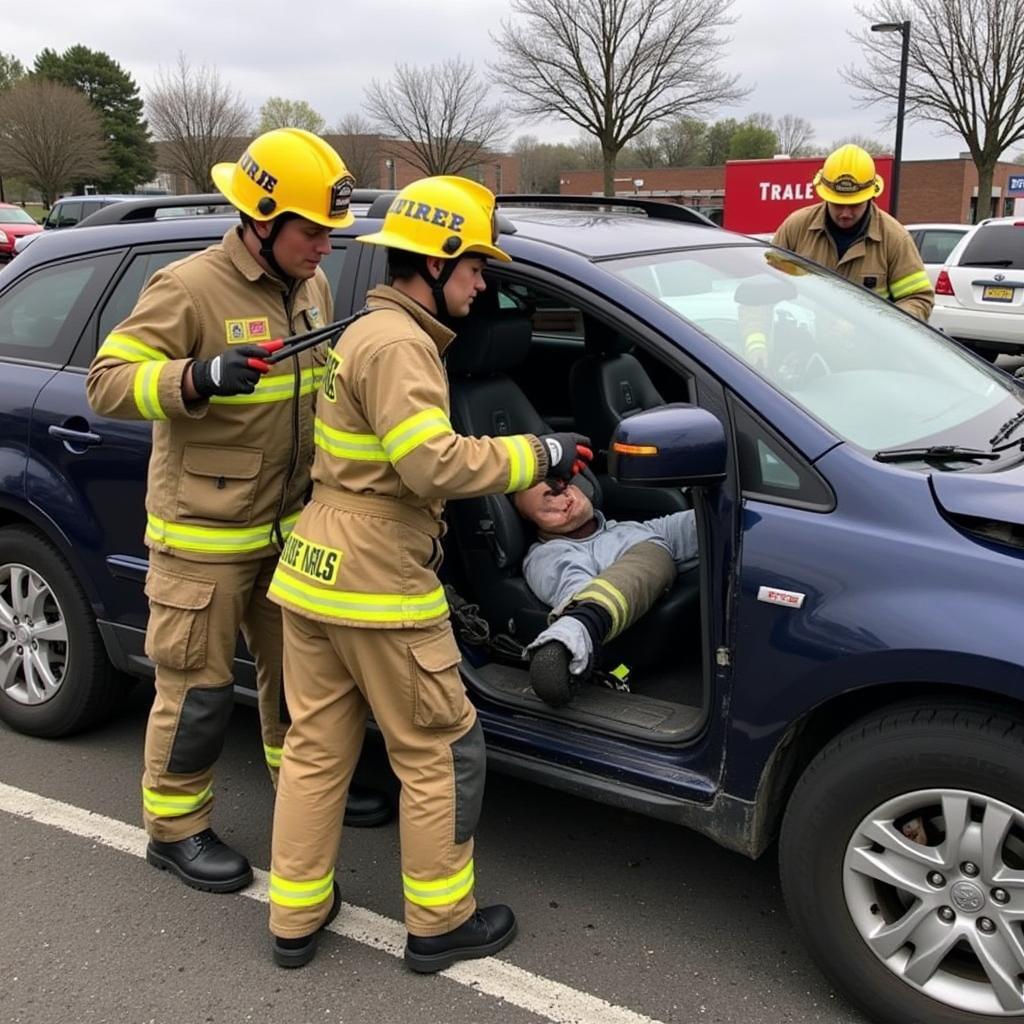A rescue tool rep recently cut a guy out of a car, highlighting the vital role these tools and trained professionals play in emergency situations. This article delves into the world of vehicle extrication, exploring the tools, techniques, and training involved in safely rescuing individuals trapped in vehicles.
Understanding the Need for Vehicle Extrication
Vehicle extrication, often referred to as “cutting someone out of a car,” is a complex and delicate process required when a person is trapped inside a vehicle following a collision, rollover, or other incident. The goal is to remove the victim quickly and safely, minimizing further injury. While it might seem like a straightforward task of simply cutting through metal, the reality involves careful planning, specialized equipment, and a highly trained team.
The necessity of vehicle extrication stems from various factors. Sometimes, the vehicle’s doors are jammed shut due to impact damage. In other cases, the victim may be pinned by the steering wheel, dashboard, or other debris. Extrication also becomes crucial when a vehicle is unstable, posing a risk of further collapse or fire.
 Hydraulic Rescue Tools in Action
Hydraulic Rescue Tools in Action
The Tools of the Trade: A Closer Look at Rescue Equipment
The rescue tool rep mentioned earlier likely employed hydraulic rescue tools, commonly known as the “Jaws of Life.” This powerful equipment comprises several key components:
- Hydraulic Spreaders: These tools use hydraulic pressure to spread metal apart, creating an opening to access the victim. They are essential for opening jammed doors, creating space within the crushed vehicle, and removing obstacles.
- Hydraulic Cutters: Designed to cut through various materials like steel, aluminum, and reinforced plastic, these cutters sever metal parts that cannot be spread or pried open. They are commonly used to remove the roof or doors of a vehicle.
- Hydraulic Rams: These tools provide powerful pushing force to displace or move heavy objects. They can be used to push the dashboard away from the victim, create space for rescuers to work, or stabilize the vehicle.
Beyond the “Jaws of Life,” other tools play a crucial role in vehicle extrication, such as:
- Stabilization Equipment: This includes cribbing, struts, and chains used to secure the vehicle and prevent further movement during the extrication process.
- Cutting Tools: Reciprocating saws, air chisels, and other powered cutting tools provide alternative means of cutting through metal or other materials.
- Hand Tools: Hammers, pry bars, and hand-powered cutters are used for finer adjustments and access to tight spaces.
The Expertise Behind Extrication: Training and Techniques
Successfully rescuing someone trapped in a car requires more than just powerful tools. It demands extensive training and a thorough understanding of vehicle construction, extrication techniques, and emergency medical procedures. Rescue personnel undergo rigorous training to learn how to:
- Assess the Scene: Identifying hazards, evaluating the vehicle’s stability, and determining the number and condition of victims are crucial initial steps.
- Stabilize the Vehicle: Securing the vehicle prevents further movement and collapse during extrication.
- Gain Access: Creating an opening into the vehicle requires careful planning and precise tool application.
- Disentangle the Victim: This involves removing debris, cutting or spreading metal, and carefully maneuvering the victim to minimize further injury.
- Coordinate with Medical Personnel: Working seamlessly with paramedics and other medical professionals ensures the victim receives immediate medical attention.
Rescue Tool Rep Cut Guy Out of Car: A Real-World Example
The scenario of a rescue tool rep cutting someone out of a car exemplifies the critical role these professionals play, not just in selling equipment, but also in demonstrating its proper use and life-saving potential. This hands-on experience is invaluable for emergency responders, providing them with practical knowledge and confidence in using these complex tools.
“The ability to swiftly and safely extricate a trapped victim is often the difference between life and death,” says Dr. Emily Carter, Emergency Medicine Physician at Chicago General Hospital. “Proper training and advanced tools are essential in these time-critical situations.”
Conclusion: The Vital Role of Vehicle Extrication and Rescue Tools
The act of a rescue tool rep cutting a guy out of a car underscores the importance of these tools and the skilled professionals who utilize them. From the hydraulic “Jaws of Life” to advanced stabilization techniques, vehicle extrication demands specialized equipment and extensive training. DiagFixPro recognizes the critical role of this life-saving process, providing valuable information and resources to support those dedicated to ensuring the safety and well-being of others.
FAQs
-
What are the most common tools used in vehicle extrication?
Hydraulic spreaders, cutters, and rams are the most commonly used tools. -
How long does a typical vehicle extrication take?
The time can vary depending on the complexity of the situation, but it can range from a few minutes to over an hour. -
What type of training do rescue personnel receive for vehicle extrication?
Rescue personnel undergo extensive training that includes vehicle construction, extrication techniques, and emergency medical procedures. -
How is the safety of the victim ensured during extrication?
Stabilization techniques, careful tool application, and close coordination with medical personnel ensure victim safety. -
What are the common causes of vehicle entrapment requiring extrication?
Collisions, rollovers, and other incidents that cause vehicle damage and trap occupants are common causes. -
What is the role of a rescue tool rep?
A rescue tool rep sells and demonstrates the use of extrication equipment, providing valuable training to emergency responders. -
Where can I find more information on car diagnostic tools and techniques?
Check out our other articles on DiagFixPro, including “Advanced Diagnostics for Modern Vehicles” and “Troubleshooting Common Car Problems.”
For support, contact us via WhatsApp: +1(641)206-8880, Email: cardiagtechworkshop@gmail.com or visit our office at 910 Cedar Lane, Chicago, IL 60605, USA. We have a 24/7 customer support team.

Leave a Reply